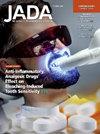影响牙源性小儿面部蜂窝织炎发病及病程的因素
IF 3.1
2区 医学
Q1 DENTISTRY, ORAL SURGERY & MEDICINE
引用次数: 0
摘要
牙源性面神经蜂窝织炎(FCOO)是牙源性面神经蜂窝织炎的一个严重后果。儿科患者在医院寻求非创伤性和紧急牙科治疗的比例高于其他医疗条件。确定影响FCOO发病和治疗过程的因素可以对医疗系统产生深远的影响。方法回顾性分析在某儿科医院牙科门诊就诊并诊断为FCOO的患者的电子病历。收集的数据是描述性变量,这些变量与他们的口蹄炎治疗过程、口蹄炎与牙科之家是否存在之间的关系、口蹄炎治疗中高级行为指导的使用以及有特殊卫生保健需求的儿童和青少年与口蹄炎之间的任何关系有关。结果数据来自201名参与者,平均(SD)年龄为7.5(4.1)岁。面部肿胀的病因为龋齿(73.1%)、牙体修复治疗失败(22%)、口腔病理(2.9%)和牙外伤(2%)。结论:无首次牙科就诊史的患者、未建立牙科家庭的患者、较年轻的患者和有特殊保健需求的患者对FCOO的护理需要比同类患者更多的强化治疗。实际意义牙科之家应该提倡,但在临床实践中,它可能不利于某些患者的日常和紧急口腔保健需求。如果需要住院治疗FCOO,医疗和牙科团队成员之间的跨学科沟通是必要的。本文章由计算机程序翻译,如有差异,请以英文原文为准。
Factors influencing onset and course of odontogenic pediatric facial cellulitis
Background
A severe consequence of unmet dental needs and failed treatment is the development of facial cellulitis of odontogenic origin (FCOO). Pediatric patients seek treatment for nontraumatic and urgent dental conditions at hospitals at higher rates relative to other medical conditions. Determining the factors influencing the onset and course of care for FCOO can have profound effects on medical systems.
Methods
The electronic health records of patients who sought treatment at a pediatric hospital dental clinic and received a diagnosis of FCOO were reviewed. Data collected were descriptive variables related to the course of care for their FCOO, the associations between FCOO and the presence or absence of a dental home, the use of advanced behavior guidance in the treatment of FCOO, and any associations between children and adolescents with a special health care need and FCOO.
Results
Data were collected from 201 participants with a mean (SD) age of 7.5 (4.1) years. The etiology of facial swelling was caries (73.1%), failed dental restorative treatment (22%), oral pathology (2.9%), or dental trauma (2%).
Conclusions
Patients without history of a first dental visit, patients without an established dental home, younger patients, and patients with a special health care need required a more intensive course of care for FCOO than their counterparts.
Practical Implications
The dental home should be advocated for, but in clinical practice it may not facilitate certain patients’ needs for routine and emergency oral health care. If an inpatient stay for FCOO becomes necessary, interdisciplinary communication between the medical and dental team members is necessary.
求助全文
通过发布文献求助,成功后即可免费获取论文全文。
去求助
来源期刊

Journal of the American Dental Association
医学-牙科与口腔外科
CiteScore
5.30
自引率
10.30%
发文量
221
审稿时长
34 days
期刊介绍:
There is not a single source or solution to help dentists in their quest for lifelong learning, improving dental practice, and dental well-being. JADA+, along with The Journal of the American Dental Association, is striving to do just that, bringing together practical content covering dentistry topics and procedures to help dentists—both general dentists and specialists—provide better patient care and improve oral health and well-being. This is a work in progress; as we add more content, covering more topics of interest, it will continue to expand, becoming an ever-more essential source of oral health knowledge.
 求助内容:
求助内容: 应助结果提醒方式:
应助结果提醒方式:


